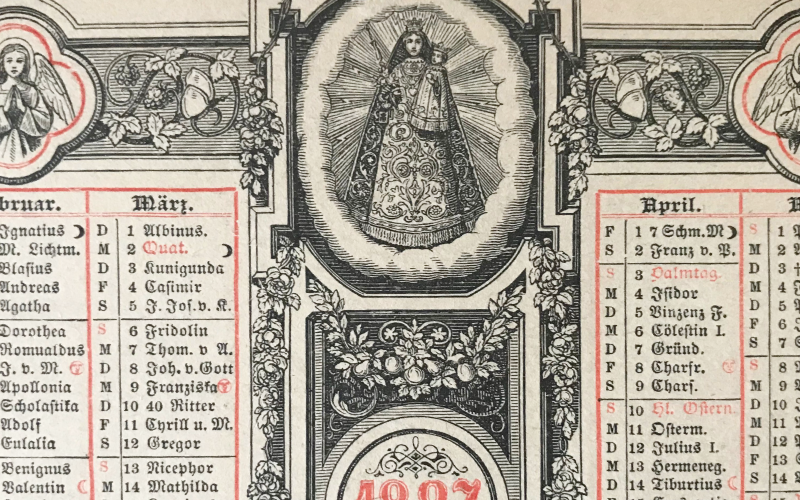An unfortunate slander sometimes hurled against Traditional Roman Catholics who keep the 1962 Liturgical Calendar (or the ones previous) is that they are not keeping the same calendar which Christ’s Church on earth keeps. The claim that the Novus Ordo’s 1969 Calendar (with subsequent modifications since then) is the only calendar which all Catholics must follow is manifestly false.
A Diversity of Rites, a Diversity of Calendars
There are more than 20 different Catholic Rites and several Churches which are all in Communion with and under obedience to Rome. All these Catholics are fully Catholic in the complete sense. And they all have their own unique calendars with different saints commemorated and different days in the temporal cycle as well.
As a reminder, the Church’s liturgical calendar is comprised of two different, concurrent annual cycles.
First, the Proper of the Seasons, or Temporal Cycle, traces the earthly life of Our Lord Jesus Christ. In the Roman Catholic Church, it consists mainly of Sundays related to the various liturgical seasons – that is, the seven liturgical seasons contained in the two cycles previously discussed: the Christmas Cycle and the Easter Cycle. It starts with Advent then goes through Christmas, Epiphany, Septuagesima, Lent, Easter, and Time after Pentecost. The determination of the date of Easter dictates nearly all the other dates in this cycle.
But there is a second cycle: the Proper of the Saints, called the Sanctoral Cycle, which is the annual cycle of feast days not necessarily connected with the seasons.
The Rites of various Eastern Catholic Churches (e.g., the Byzantine Rite, the Syro Malabar Rite, etc.) use entirely separate calendars with separate saints commemorated, separate Holy Days of Obligation, and separate days of fasting and abstinence. And there is no doubt they do so with the Church’s blessing.
A Diversity of Days Even in the Roman Catholic Church
Beyond the Roman Rite, the Ambrosian, Mozarabic, Lyon, and Bragan Rites are also all part of the Western liturgical tradition. So too are the various Rites for religious orders (e.g., the Carmelite Rite, the Dominican Rite). There are various Uses as well, such as the Anglican Use (i.e., the Ordinariate) – which was only recently approved under John Paul II. These are also part of the Roman Catholic Church.[1]
Even in the Roman Rite itself, various dioceses, countries, and religious orders keep some different feast days. These are listed in the “Mass in Some Places” (pro aliquibus locis) supplement to the pre-1965 Missals. No one has ever doubted the legitimacy of this liturgical diversity.
Summorum Pontificum Affirmed the Use of the 1962 Calendar
Summorum Pontificum is the celebrated motu proprio issued by Pope Benedict XVI on July 7, 2007, that addresses the use of the Roman Missal of 1962, more commonly called the Traditional Latin Mass. (The phrase ‘Tridentine Mass’ is also used, but one should be careful not to thereby make the error of thinking this rite originated at the Council of Trent.) While Summorum Pontificum primarily deals with the use of the 1962 Missal, it also addresses the liturgical calendar associated with that Missal. Regarding the liturgical calendar, Summorum Pontificum states that:
- The Missal of 1962 includes its own liturgical calendar. This calendar differs significantly from the General Roman Calendar of 1969, which is used by the Novus Ordo
- Priests who celebrate the Mass according to the 1962 Missal are permitted to use the liturgical calendar of that Missal, including its particular feasts, commemorations, and rankings of liturgical days.
- Summorum Pontificum allows for the celebration of the Missal of 1962 in its entirety, including the liturgical calendar, without requiring any adjustments to conform to the calendar of 1969. This means that the feasts, liturgical seasons, and calendar customs associated with the 1962 Missal can be preserved when celebrating the Tridentine Mass.
Hence, Summorum Pontificum affirmed the continued use of the liturgical calendar associated with the 1962 Roman Missal for those who celebrate the Traditional Mass, allowing for the preservation of the liturgical traditions and feasts specific to that Missal.
There is No “One” Catholic Calendar of Saints
Those who try to discredit the Traditional Latin Mass may try to falsely claim that all Catholics must observe the same calendar of saints. But this is not the case, as seen in the liturgical calendar diversity in the different Rites of the Church and in the Roman Rite itself. Even Summorum Pontificium affirmed the continued use of the 1962 calendar in the traditional Mass and Breviary is permissible.
Let us return to observe the 1962 Missal (or even the prior 1954 Missal before the weakening changes introduced in 1955) in our own personal lives. The Vatican previously gave permission to a number of traditional Orders to keep the pre-1955 Missal and the traditional Holy Week liturgies.
The Fatima Center Devotional Calendar is an excellent aid to help us to do this. And let us do so without any doubt whatsoever that we continue to observe a viable and robust calendar blessed by the Catholic Church.
Note: Fr. Rodríguez speaks both about the Church’s liturgical calendar in general and The Fatima Center’s Devotional Calendar in particular in a recent Fatima Center podcast.
ENDNOTES
[1] A “Use” refers to “the special liturgical customs which prevailed in a particular diocese or group of dioceses,” as stated in the Catholic Encyclopedia. The Anglican Use is one Use in the Roman Rite and is mainly for those Catholics who have converted to the Catholic Faith from Anglicanism.




